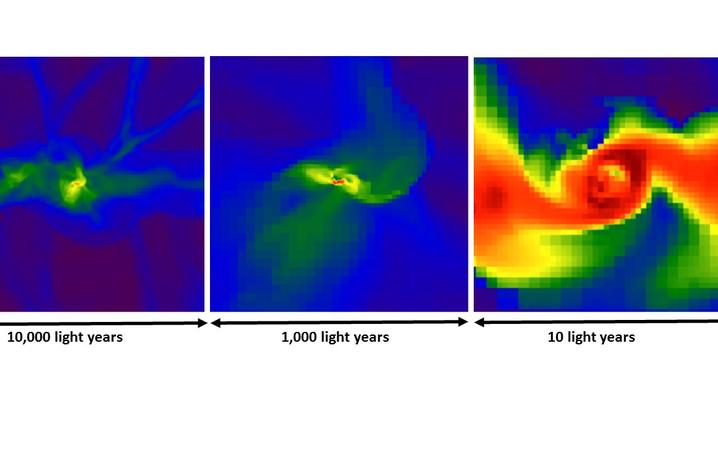Supermassive Black Holes Do Not Form from Stellar Black Holes

LEXINGTON, Ky. (April 6, 2016) — Often containing more than a billion times the mass than our Sun, supermassive black holes have perplexed humans for decades. But new research by University of Kentucky astrophysicist Isaac Shlosman and collaborators will help to understand the physical processes at the edge of time and space, providing the details of how supermassive black holes formed 13 billion years ago.
Shlosman, as well as Jun-Hwan Choi at the University of Texas at Austin, Mitchell Begelman at the University of Colorado Boulder, and Kentaro Nagamine at Osaka University (Japan), ran simulations where supermassive black holes are seeded by clouds of gas falling into potential wells of dark matter — the invisible matter that astronomers believe makes up 85 percent of the mass in the universe.
The researchers found that while most seed particles in their simulations did not grow very much, one central seed grew rapidly to more than two million times the mass of our Sun in just two million years, demonstrating a feasible path toward a supermassive black hole.
"Of course pointing for a feasible path does not mean yet that we went all the way and formed such a bizarre object," said Shlosman, who is a professor in the UK Department of Physics and Astronomy. "Much more work is required. In a way this is a collective effort."
Dark matter dominates gravity in the universe and forms structures; as the universe expands, the dark matter clumps together and cannot cool down, forming dark matter wells, he explained.
"Clouds of gas can fall into the potential wells of dark matter and collapse, forming supermassive black holes," he said. "There are many obstacles on this way."
It was previously assumed by many that supermassive black holes were simply normal, or stellar, black holes that grew over time, but newly discovered quasars — bright and distant objects which contain supermassive black holes, make this option less likely. Some of the distant quasars observed recently already existed 700 million years after the Big Bang. It would be very difficult to grow supermassive black holes from stellar size black holes in such a short time after the Big Bang.
An additional argument that supermassive black holes were seeded by the collapse of some of the first stars has also been debunked as "we have learned that those first stars were rather of normal size and collapsed into normal black holes," Shlosman said.
"Normal black holes and supermassive black holes are completely different beasts," he said.
Indeed, the simulations produced by supercomputers at UK and Osaka University plausibly show that supermassive black holes form by a completely different process than normal (stellar) black holes. The researchers expect their simulations to be validated when NASA’s James Webb Space Telescope, due to be launched in 2018, observes distant sources where direct gas collapse is happening.
"We're at the forefront, but many questions remain," Shlosman said. "But the public and their curiosity deserve to have those answers; we cannot exclude anything if we want to keep advancing."
UK is the University for Kentucky. At UK, we are educating more students, treating more patients with complex illnesses and conducting more research and service than at any time in our 150-year history. To read more about the UK story and how you can support continued investment in your university and the Commonwealth, go to: uky.edu/uk4ky. #uk4ky #seeblue
MEDIA CONTACT: Whitney Harder, 859-323-2396, whitney.harder@uky.edu




